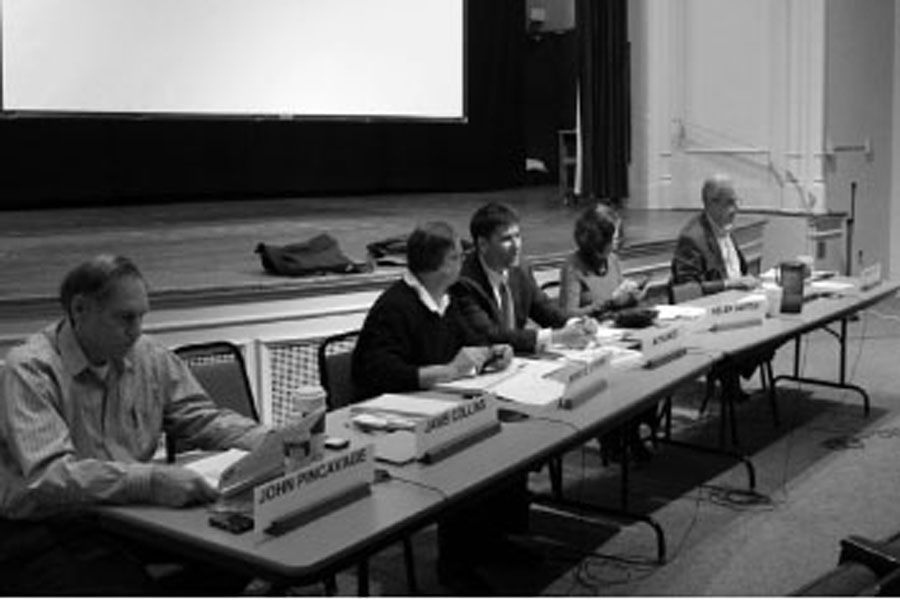The Board of Education’s $104.2 million 2013-2014 school budget represents a 3.95 percent increase over this year’s budget.
Changed points in this year’s proposal include the middle school STEM engineering program; a decrease in the second grade class size; and a reduction in the amount of money set aside in health insurance reserves, an accounting change that won’t affect staff coverage. Although students may not directly feel the changes, each year of tight budget cuts is a step closer to eating away at programs and services.
Superintendent Elliott Landon’s proposed budget originally increased the budget by 5.15 percent. Most of the BOE’s reductions to Landon’s proposal were in “behind the scenes” accounting and cash management adjustments, according to BOE chair Elaine Whitney. However, the BOE also reduced funding for supplies and equipment by $50,000. Landon chose to reduce funds in the equipment area, leaving supplies intact.
Supplies are already at a bare minimum, according to Landon and Principal John Dodig.
The budget process begins in a conference room, where school administrators meet with Landon to discuss costs—textbooks, equipment, furniture, personnel—to be covered in the budget proposal.
In discussion with administrators, Landon initially called to increase per-pupil spending on supplies by 10 percent. According to Landon, despite rising inflation, per pupil spending has stayed the same for almost 10 years. His initial proposal for an increase was lauded by principals.
“There was a round of applause,” Dodig said. “Two weeks later, we had to find $50,000 to cut.”
For the high school, the tight parameters of the budget meant that supplies like microscopes and other science equipment, laptops and smartboards, and 150 iPads for the social studies and English departments, although requested, will not be purchased for the coming year, Dodig said.
The 2013-2014 budget may still undergo further pruning. A version has been approved by the BOE, but the sum total cost still must be approved by the Board of Finance (BOF) and Representative Town Meeting (RTM), bodies that may further reduce the number.
But the Superintendent is concerned that there’s little left to cut. “We try to put together a bare-bones budget,” Landon said. “We’ve trimmed out any fat. It’s all skin and bone.”
About 95 percent of the budget covers nonnegotiable costs, including property expenses, the wireless network, and staff salaries and benefits. “It doesn’t leave you a lot of money for discretionary expenditures,” said Nancy Harris, Assistant Superintendent for Business.
A budget maintaining current expenditures would require a 4.44 percent increase to compensate for enrollment and inflation, about 0.5 percent more than the current proposal. Even small percentage discrepancies have an effect when one percent of the budget is roughly $1 million.
Dodig is worried that keeping spending on such a tight rein will eat away at Staples’s edge, an edge gained by advanced technology and a progressive curriculum.
“We have a lighthouse district school in danger of becoming a historic lighthouse district school,” Dodig said.
Brian Tippy, an English teacher, was involved in developing ideas for an iPad driven curriculum. “I wish they could have found the money,” Tippy said. “We have a lot of great stuff ready to go for kids.”
Although iPads and science equipment have vanished from the budget plan, the cuts reflect a determination to leave people and programs intact.
Still, Landon is concerned for the future of the budget draft, as it is shaped by BOF and RTM input.
“I’m hopeful that the Board of Finance won’t cut further but fearful that they will,” he said. “Any further cuts will probably bring significant program reduction.”
“When people and programs are cut, you’ll see some draconian decreases to what we’ll offer students,” Dodig added.
According to Whitney, the BOF is aiming even lower than the 3.95 percent increase, having asked the BOE for a figure as close to last year’s 2.2 percent as possible.
The town funding bodies evaluate the school budget, about two-thirds of the town’s total expense, as a piece in a bigger system: the town and taxpayers as a whole.
“The higher the budget, the greater the tax increase,” said Hadley Rose, moderator of the RTM. “Westport has offered relatively low taxes with superior services. You want to be able to improve, but you have to recognize that these things cost money.”
Although real estate values in Westport have increased this year, there are other factors that require tight spending, said Avi Kaner, chairman of the BOF. The BOF aims to keep tax increases smooth and in line with surrounding communities, Kaner said.
Financial obligations, including post-retirement benefits, are another concern that prioritize tight spending. According to Mike Rea, a member of the BOF, the town owes money in pensions and benefits to town employees. “It’s a fixed cost for the future,” Rea said. “We can’t ignore our debt. We want to maintain the quality of life but make sure that when we spend money, we do it wisely.”
Wise spending is something that Rose sees as a benefit of a strict budget.
“Budgets of two and three percent increases forced people to be more efficient,” he said.
Rose and Rea both felt that with discussion, efficiency could further be increased without compromising students.
“You can’t always cut and chip away. There’s a point where there’s no money to cut,” Rose said. “We haven’t gotten there yet.”
The future of the budget lies with the BOF and RTM. In its March 6 meeting, the BOF had a preliminary discussion about the proposal. On March 21, after discussion with the BOE, the BOF will recommend to the RTM to reduce or maintain the budget, evaluating its total sum.
The RTM, which communicates with the BOE, BOF, and other evaluating committees, will then approve the budget, with the ability to maintain the BOF recommendation or restore the original BOE proposal after hearing appeals from BOE members.
The BOE will adopt a finalized 2013-2014 in May or June.















































